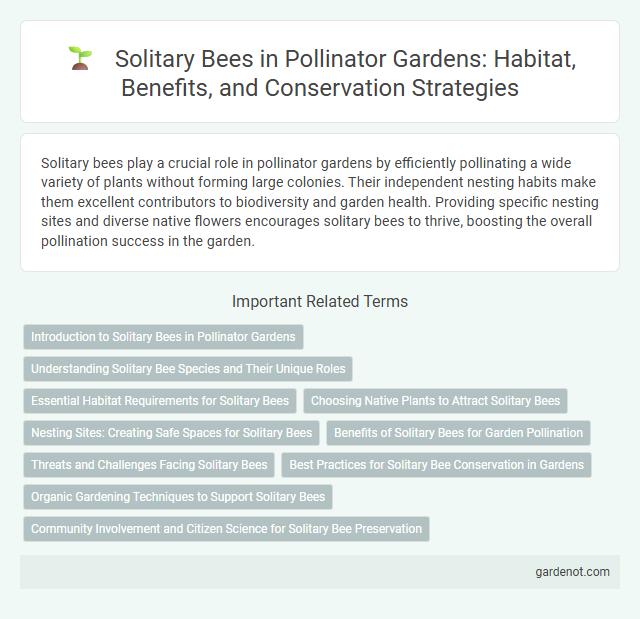Solitary bees play a crucial role in pollinator gardens by efficiently pollinating a wide variety of plants without forming large colonies. Their independent nesting habits make them excellent contributors to biodiversity and garden health. Providing specific nesting sites and diverse native flowers encourages solitary bees to thrive, boosting the overall pollination success in the garden.
Introduction to Solitary Bees in Pollinator Gardens
Solitary bees, unlike social honeybees, nest individually in soil, wood, or plant stems, making them essential pollinators in gardens. Their efficient pollination of flowers directly supports biodiversity and improves fruit and seed production in pollinator gardens. Incorporating solitary bee habitats increases garden productivity and promotes a healthy, balanced ecosystem.
Understanding Solitary Bee Species and Their Unique Roles
Solitary bee species, unlike social bees, nest individually in hollow stems or soil, playing specialized roles in pollination by targeting specific plants. Their unique foraging behaviors enhance biodiversity and improve fruit and seed production in pollinator gardens. Understanding the nesting habits and plant preferences of solitary bees is crucial for creating habitats that support their populations and boost garden ecosystems.
Essential Habitat Requirements for Solitary Bees
Solitary bees require diverse floral resources that provide abundant pollen and nectar throughout their active season. Essential habitat components include undisturbed nesting sites such as bare soil, hollow stems, or dead wood, which offer safe places for egg-laying and larval development. Maintaining pesticide-free environments and proximity to water sources further supports their successful reproduction and population stability.
Choosing Native Plants to Attract Solitary Bees
Selecting native plants such as wild indigo, coneflowers, and goldenrod enhances solitary bee attraction by providing essential nectar and pollen throughout their active seasons. These plants support native bee populations by matching their foraging needs and flowering times, promoting effective pollination and biodiversity. Incorporating a variety of native blossoms with staggered bloom periods ensures continuous food sources critical for solitary bee nesting and reproduction.
Nesting Sites: Creating Safe Spaces for Solitary Bees
Solitary bees thrive in well-prepared nesting sites that mimic their natural habitats, such as hollow stems, dead wood, and bare soil patches. Providing nesting blocks with varied hole diameters supports different solitary bee species, enhancing pollination diversity in pollinator gardens. Protecting these nesting areas from pesticides and disturbance ensures solitary bees can safely reproduce and contribute to ecosystem health.
Benefits of Solitary Bees for Garden Pollination
Solitary bees significantly enhance garden pollination by efficiently transferring pollen between flowers, leading to higher fruit and seed yields. Their non-aggressive nature allows them to thrive in various garden environments, increasing plant biodiversity and ecosystem resilience. Unlike social bees, solitary bees require minimal maintenance, making them ideal natural pollinators for sustainable gardening practices.
Threats and Challenges Facing Solitary Bees
Solitary bees face significant threats from habitat loss due to urbanization and intensive agriculture, which reduces the availability of native flowering plants essential for foraging. Exposure to pesticides, particularly neonicotinoids, disrupts their nervous systems and reproductive capabilities, leading to population declines. Climate change also alters blooming periods and nesting habitats, further challenging the survival of solitary bee species in pollinator gardens.
Best Practices for Solitary Bee Conservation in Gardens
Provide diverse native flowering plants that bloom throughout the growing season to supply continuous nectar and pollen for solitary bees. Avoid using pesticides and herbicides to create a safe environment, and incorporate nesting habitats like bare soil patches or bee hotels with appropriately sized tunnels. Maintain garden areas with minimal disturbance to support solitary bee lifecycle and promote population health.
Organic Gardening Techniques to Support Solitary Bees
Solitary bees thrive in organic gardening environments that avoid synthetic pesticides and use natural pest control methods. Incorporating diverse native flowering plants and providing bare soil or wood nesting sites enhances solitary bee habitat within the garden. Composting and mulching with organic materials further improve soil health, supporting the pollinator-friendly ecosystem essential for solitary bee populations.
Community Involvement and Citizen Science for Solitary Bee Preservation
Community involvement in solitary bee preservation fosters local stewardship through pollinator garden initiatives that provide essential habitats. Citizen science projects engage volunteers in monitoring solitary bee populations, contributing valuable data for conservation strategies. These collaborative efforts enhance biodiversity and support the vital pollination services solitary bees offer to ecosystems.
Solitary bee Infographic

 gardenot.com
gardenot.com